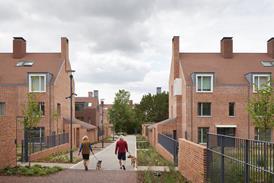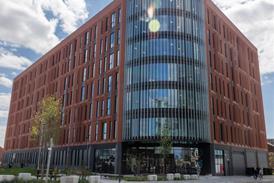Green infrastructure has huge potential to help shape public spaces for the better, writes Omri Ben-Chetrit

Throughout my professional journey my passion and expertise have been dedicated to projects in the public realm and open spaces. This focus stems from my recognition of the immense potential these areas possess for fostering meaningful social interactions, cultivating inclusive environments, and playing a vital role in addressing climate and ecological objectives.
I grew up and obtained my architecture degree in Israel before relocating to London in 2016. I had the opportunity to work as a landscape architect in a large commercial practice and pursue a master’s degree before joining the Public Practice Associate Programme. I then assumed the role of a green infrastructure officer at Somerset West and Taunton Council (now Somerset Council).
While working on various public realm projects in architectural practice, I observed how political and economic pressures influenced design decisions. Other aspects of design were often prioritised, and as a result, many projects failed to integrate green features into the design properly, thus not maximising their potential from a green infrastructure perspective.
As a designer, my primary role was finding solutions within the constraints of a predetermined vision and navigating inherent limitations. This was a challenging and rewarding role. However, my ambition to be part of the team that shapes its own vision and works directly with the community to develop site-specific objectives for places, motivated me to move to the public sector.
I decided to make the transition into the public sector through the Public Practice programme, which provided me with a profound understanding of the work being carried out within this sector. The programme also provided me with insights into the structure and functioning of the public sector and guided me in navigating through it.
Being part of the Taunton Strategic Sites team, I have gained insights into the wide range of issues involved in designing large and complex projects
My placement as a green infrastructure officer at Somerset West and Taunton Council encompasses a variety of workstreams. I am responsible for implementing projects identified within the town’s green infrastructure strategy and providing specialist advice in this area as well as landscape issues for planning applications.
As the green infrastructure network comprises all types of open spaces, from large natural and semi-natural areas to street trees, and pocket gardens, it is an integral part of every development and planning application. This means I am involved to some extent in many of the town’s future developments.
Being part of the Taunton Strategic Sites team, I have gained insights into the wide range of issues involved in designing large and complex projects. I have also witnessed the level of expertise that the council possesses in-house, allowing it to bring together different opinions, knowledge, and perspectives to enhance any scheme and improve the quality of places in the local area.
As I see it, the main challenge as a planner is to strike a delicate balance and facilitate effective mediation among a wide range of needs and perspectives. My responsibility within the team is to ensure the smooth integration of existing and new green features in developments and ensure that green infrastructure is considered a material factor, encouraging the implementation of best-practice design solutions.
When I joined Somerset West and Taunton Council, I not only made the transition from the private sector to the public sector but also experienced working in a rural context for the first time. I was interested in observing the team’s deliberations on the challenge of planning a place sustainably while preserving its distinctive rural character.
Up until then, I had believed that cities with high densities had greater potential to create a sustainable environment. However, my work at the council opened my eyes to the potential for sustainable development in rural areas and the crucial role of green infrastructure in supporting this objective.
These days, there is widespread recognition of the importance of high-quality green infrastructure
This motivated me to prepare a green infrastructure checksheet document, which aimed to bridge the gap between national and regional requirements whilst considering the specific local needs, context and character. The document compiles relevant guidance and policies at the national level, along with the council’s requirements.
In addition to ensuring that green infrastructure is included in the proposal, its purpose is to facilitate a constructive dialogue among council officers, and between officers and applicants. This dialogue aims to explore ways to implement high-quality green infrastructure features that align with local aspirations and address national and global challenges.
These days, there is widespread recognition of the importance of high-quality green infrastructure. This understanding is reflected in national-level policies, such as the Environment Act 2021 and the Levelling Up & Regeneration Bill, which emphasise the need to address nature recovery, climate change mitigation, and access to nature. Green infrastructure has the potential to provide answers to these and other challenging regional and global problems.
I think that the growing awareness of the importance of green networks makes this an exciting time to be a planner. We now have a unique opportunity (and I think we have no other option) to enhance and strengthen green infrastucture within the built environment.
This shift in priorities provides an opportunity to find new ways of integrating nature, resulting in cities that holistically embrace the natural environment. By doing so, we can contribute to the creation of more sustainable, visually attractive, and highly livable urban spaces, whilst actively supporting climate and ecological targets.
As we are only at the beginning of this journey, we have the opportunity to think and assess various solutions and approaches.
One aspect of the public sector that appeals to me is the constant need to be aware of global and regional challenges, and developing tailored responses that address specific contexts. This demands an ongoing process of learning, adaptation, creativity, and flexible thinking, resulting in ever varied and evolving work.
It is difficult to predict where my professional path will lead me to, but I hope to remain open-minded, conscious of global challenges, and curious in finding context-specific solutions in my work.
Postscript
Omri Ben-Chetrit is a Public Practice associate and a green infrastructure officer at Somerset West and Taunton Council.
Would you like to learn more about Public Practice’s work, or read about the Associate Programme? Visit Public Practice’s website for more information and resources.
















No comments yet